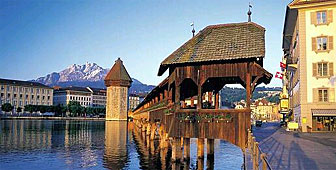Torture tour a real hit in Lucerne

Medieval crime and punishment is the theme of a new walking tour of the old town of Lucerne.
My guide, Anne-Marie Taylor, shows me the place where the Reuss River running through the old town is at its deepest – the spot where suspected criminals in the Middle Ages were taken to be drowned.
Taylor turns to me and asks, “Do you want to know why Amnesty International has objected to this tour?”
I had been waiting to ask the very same question.
“Amnesty International felt it could have a negative effect on people hearing about this kind of torture, which still exists in several parts of the world,” she explains.
In medieval Lucerne, the suspected criminal was tied and bound before being thrown into the river. If he drowned, he was deemed not to have been possessed by the devil and granted a Christian burial. Those who survived this first form of death by torture were considered beyond redemption and burned at the stake.
“We feel, and I myself as well,” she continues, “that a tour like this is very interesting for all those who want to know more about history, who have had a certain superficial knowledge of what torture, of what the judicial system was like in the Middle Ages.
Fundamentalism and fanaticism
“We are just trying to tell people how fundamentalism and fanaticism are wrong [and we want] to speak to people who come from countries where perhaps the death penalty is still exercised.”
Inside the most photographed landmark of Lucerne, the Water Tower, the accused were whipped and beaten and lowered into a windowless dungeon by a rope.
Those accused of manslaughter or robbery were beheaded, witches burned, robbers, arsonists and counterfeiters hanged. Suspects found guilty of a breach of the peace were hanged, drawn and quartered. Murderers were impaled and petty thieves got off relatively lightly – with only the loss of a hand or finger.
Pleasure in torture
“It was a crime itself in taking pleasure perhaps, in torturing or putting people to death,” Taylor says.
She leads me across the covered wooden Chapel Bridge and past the church square, which once served as Lucerne’s cemetery and where many of the victims of medieval justice were at least granted a Christian burial.
Although most tourists come to Lucerne to enjoy its wonderful lakeside setting amid snow capped mountains, the well-preserved old town is also a natural stage to expose the brutality of Europe in the Middle Ages.
A Linden tree has been replanted in the Weinmarkt square, in front of a hotel façade covered with medieval frescoes. It marks the spot where a Linden tree once stood and where the accused were sentenced.
Dance of death
Not far off is the Spreuer Bridge – Lucerne’s other famous covered bridge across the Reuss. An impressive series of 17th century Dance of Death paintings on triangular panels hang under the eaves.
“They are portraits of people who lived here around 1620 when the paintings were done,” explains Taylor. “They are of rich and poor people walking with death.
“The meaning behind it is at the end of our lives, we are all going the same way, if we are rich or poor. You mustn’t forget that the medieval person thought that with death, the real life began.”
Pausing on the bridge to look at the paintings, and up river to see the Water Tower with the lake and mountains in the background, Taylor reflects on everything she has said and remembers to tell me that the medieval hangman also had a human side.
“Executioners gained so much knowledge about the human anatomy that they were often called upon by doctors,” she says.
“If someone had a fracture, for example, doctors would consult the executioner how to heal the broken limb. These men who were feared on the one hand were useful as consultants. We know of cases of people that after being tortured were healed [by their torturer].”
Jail hotel
The tour ends fittingly with a visit to Lucerne’s “Jail Hotel”. The former prison was converted into a hotel shortly after the last inmate was released in 1998.
Because the building was protected, the new owners hit upon the idea to change little, and to offer guests the opportunity to spend a night in a real prison cell.
A walk through the corridors shows how conditions for lawbreakers vastly improved from medieval times to the 20th century, and how in the new millennium, people are even willing to pay for the criminal experience.
The “most wanted cells” as they are called, are the most expensive. The incarcerated guests are provided convicts’ dress and served bread and water.
by Dale Bechtel
Taking the tour
The “Reprieve Tour” of Lucerne lasts about three hours and costs SFr260 ($156) for the guide, who conducts groups, families or individuals. Entry to the Water Tower (normally closed to the public) and a visit to the Jail Hotel is included. A three course “last meal” at the hotel is an additional SFr26 ($16) but is not to be missed! Generous portions of Chinese and Indian dishes prepared by Asian cooks are served in the hotel’s two trendy restaurants.

In compliance with the JTI standards
More: SWI swissinfo.ch certified by the Journalism Trust Initiative
You can find an overview of ongoing debates with our journalists here . Please join us!
If you want to start a conversation about a topic raised in this article or want to report factual errors, email us at english@swissinfo.ch.